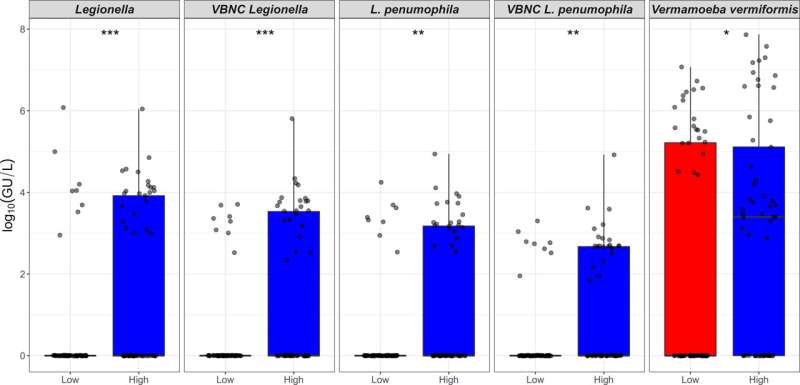This article has been reviewed according to Science X's editorial process and policies. Editors have highlighted the following attributes while ensuring the content's credibility:
fact-checked
trusted source
proofread
Simple maintenance can reduce hospital Legionella risks

Hospital water systems are a significant source of Legionella, resulting in the potentially fatal Legionnaires' disease—but Flinders University researchers have proven simple maintenance that involves running hot water regularly and flushing the pipes has a huge effect in reducing the risk of the disease.
One of the biggest challenges for Legionella management within large hospital systems is that under unfavorable conditions, Legionella transforms itself into a state (called viable but non culturable—VBNC) that cannot be detected using standard methods.
To understand the extent of the problem, Flinders University researchers conducted the first comprehensive study that quantified all Legionella, including those in the VBNC state, and free-living amoebae from a hospital water system under dynamic flow and temperature conditions.
The research, "Stagnation arising through intermittent usage is associated with increased viable but non culturable Legionella and amoeba hosts in a hospital water system," by Muhammad Atif Nisar, Kirstin Ross, Melissa Hackett Brown, Richard Bentham, Giles Best, James Xi, Jason Hinds and Harriet Whiley, has been published in Frontiers in Cellular and Infection Microbiology.
"We took a different approach because we didn't know how often the standard method was returning false negative results for Legionella and it's really hard to determine the optimal management approach if you can't trust your testing method," says Flinders University's Associate Professor Harriet Whiley.
This study used a novel method in combination with the standard detection methods to examine the effect of temporary water stagnation, on Legionella and microbial communities present in a hospital water system.
The water temperature, number and duration of water flow events for the hand basins and showers sampled was measured using a commercially available monitoring system developed by Enware Australia—and analysis demonstrated that 21.8% samples were positive for Legionella spp., 21% for L. pneumophila, 40.9% for V. vermiformis and 4.2% for Acanthamoeba.
Temporary water stagnation arising through intermittent usage (being less than two hours per month) significantly increased the amount of Legionella.
"Temporary stagnation arising through intermittent usage causes water quality to deteriorate—and this study identified that temporary stagnation for over a month promotes the persistence of Legionella," says Associate Professor Whiley.
"Similarly, free-living amoeba and heterotrophic bacteria present in this temporary stagnant environment were positively correlated with Legionella. All samples positive for Legionella were also positive for amoeba.
"Therefore, temporary stagnation and free-living amoeba must be managed for the proper control and prevention of Legionnaires' disease."
This study also showed that the standard microbiological culture method used to detect Legionella returned a false negative result for 88% of the Legionella positive samples—pointing to future research needed to investigate concentrations of Legionella that pose a risk to public health and inform improved Legionella guidelines.
More information: Muhammad Atif Nisar et al, Stagnation arising through intermittent usage is associated with increased viable but non culturable Legionella and amoeba hosts in a hospital water system, Frontiers in Cellular and Infection Microbiology (2023). DOI: 10.3389/fcimb.2023.1190631



















